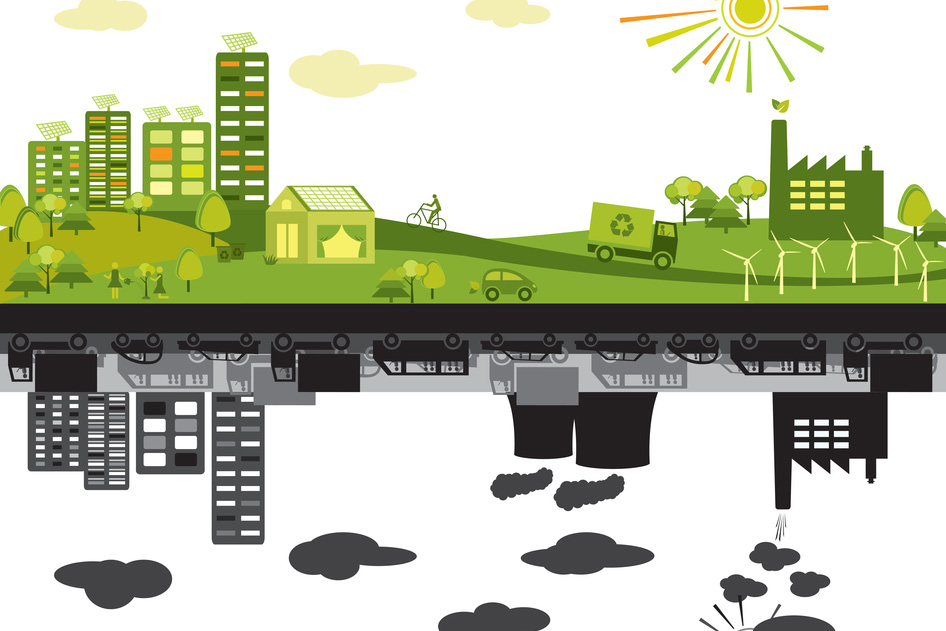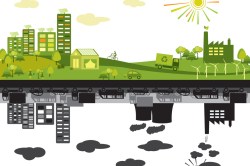Let’s just accept it: America’s current political and economic systems are incapable of responding adequately to climate change. As things stand, reducing carbon emissions — or more broadly, shifting to sustainability — is a kind of add-on, a second-tier consideration, bolted onto systems and institutions that were built for other purposes.
Specifically, U.S. domestic and foreign policy have long been designed around the Cold War, ramping up trade abroad, expanding up and out and into the suburban hinterlands at home, out-growing and out-sprawling the Soviet Union. That was the north star for U.S. policy for decades.
With the end of the Cold War, that north star vanished, and the U.S. has been adrift ever since. No grand strategy has replaced the Cold War strategy, only a kind of autopilot effort to keep the status quo limping along through rising debt, housing and financial bubbles, tax cuts, and deficit spending. It seemed for a while after 9/11 that taming the Middle East (hubris intended) would align U.S. strategy, but those efforts have been a spectacular failure.
Reducing the carbon emissions of our Cold War industrial system can have only marginal effects; that system is built on cheap fossil fuels. It is built to emit carbon. Attaching a carbon tax to that beast is like draining blood from your horse in hopes that a new horse will result.
Adequately responding to climate change is only possible within a larger industrial, economic, civic, and political system that is designed around sustainability. Sustainability must be the point of the system. Within such a context, efforts to build a better life and achieve prosperity would serve sustainability rather than work against it. Sustainability would be the source of its vitality, not an add-on, slowing it down and making it more expensive like a scrubber on a coal plant.
So what would a new U.S. grand strategy built around sustainability look like? That’s the question tackled by “A New U.S. Grand Strategy,” a piece in Foreign Policy by Patrick Doherty, director of the Smart Strategy Initiative at the New America Foundation.
It’s a hugely ambitious and wide-ranging piece, far too much to even summarize adequately here. Bookmark it. Instapaper it. Pinterest it to your iCloud, or whatever kids do these days. But let’s take a quick look.
Doherty identifies four central challenges facing the U.S.:
- Economic inclusion: People are swarming out of poverty around the world (especially in China). Over the next 20 years, the global middle class will welcome around 3 billion new members. That’s going to put intense stress on natural, economic, and political systems that are already showing signs of strain.
- Ecosystem depletion: Pretty sure Grist readers are familiar with this one.
- Contained depression: Rather than a recession, the U.S. faces a “constrained depression,” with the full effects of low aggregate demand and high debt being masked by policy. No amount of fiscal or economic stimulus will revive a system that has exhausted itself.
- Resilience deficit: Our industrial supply lines and value chains are efficient, but lack redundancy; they are brittle. Our infrastructure is old and crumbling, $2.2 trillion in the hole, and that’s just for the aging Cold War stuff, never mind building water, power, and transportation systems suited to an era of climate disruption.
“These four challenges,” Doherty says, “are the four horsemen of the coming decades.” And they are inter-dependent. They must be solved together. It’s a rough situation.
With these in mind, Doherty proposes a new grand strategic concept: “The United States must lead the global transition to sustainability.”
There’s a bunch in the piece about how this would look in foreign policy, but I want to home in on the domestic half, because it’s so refreshingly different from what you usually hear from would-be grand strategists (“pivot to the Pacific!”). Here are Doherty’s main suggestions for how to realign the U.S. economic engine:
- Walkable communities: More and more Americans want to live in dense, walkable areas; get rid of regulations that hamper them and start building them.
- Regenerative agriculture: Farmers can produce “up to three times the profits per acre and 30 percent higher yields during drought” with agricultural techniques that also clean water and restore soils. America must “adopt modern methods that will bring more land into cultivation, keep families on the land, and build regional food systems that keep more money circulating in local economies.”
- Resource productivity: “Energy and resource intensity per person will have to drop dramatically.” That imperative can drive “innovation in material sciences, engineering, advanced manufacturing, and energy production, distribution, and consumption.”
- Excess liquidity: Channel all the corporate cash that’s sitting around in funds into long-term investments in America by taxing waste and creating regional growth strategies.
- Stranded hydrocarbon assets: Figure out how to devalue the immense amount of carbon that’s still sitting underneath the ground without unduly traumatizing the economy.
Obviously the devil is in the details on this stuff, but at a broad level, this is about as eloquent and forward-thinking as it gets. I love the idea of using sustainability in a muscular way, to revive regional economies and nurture the middle class. I recommend reading the whole thing.



